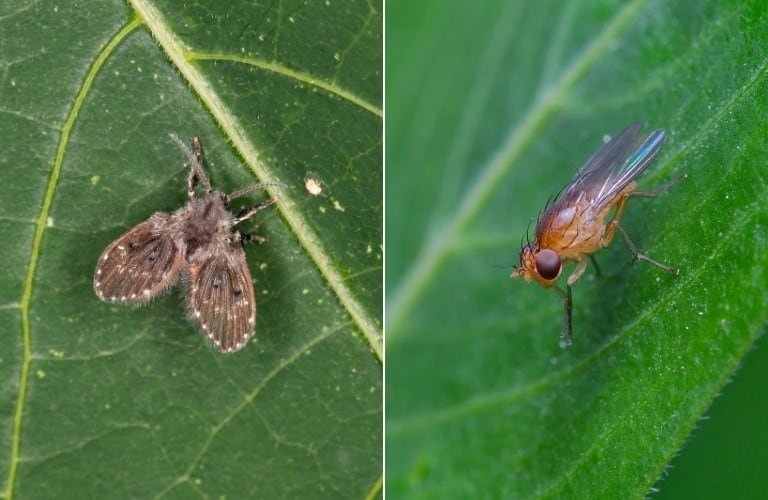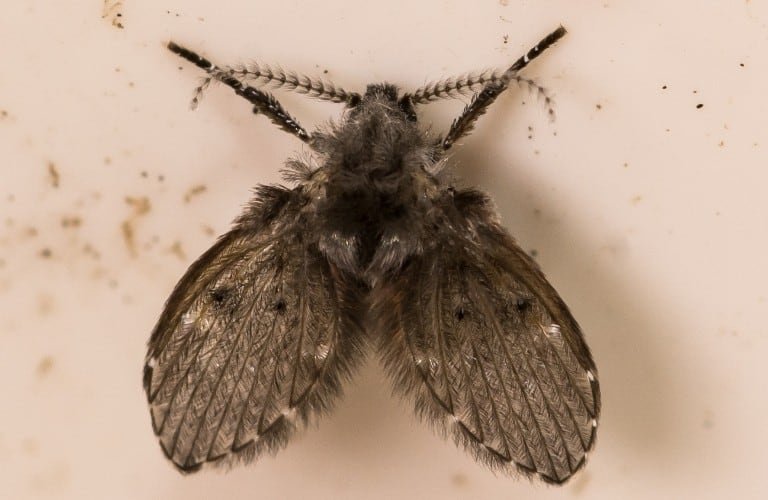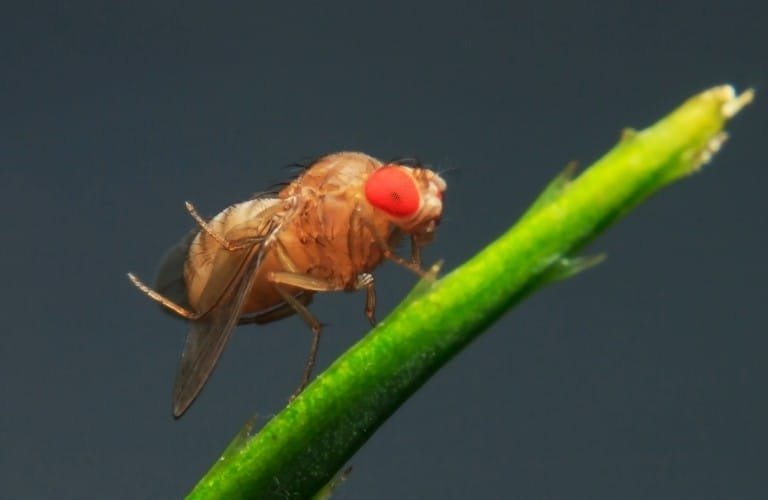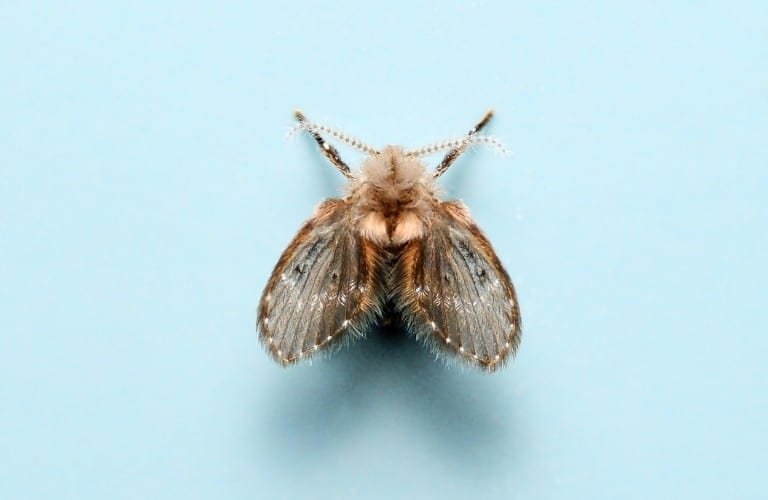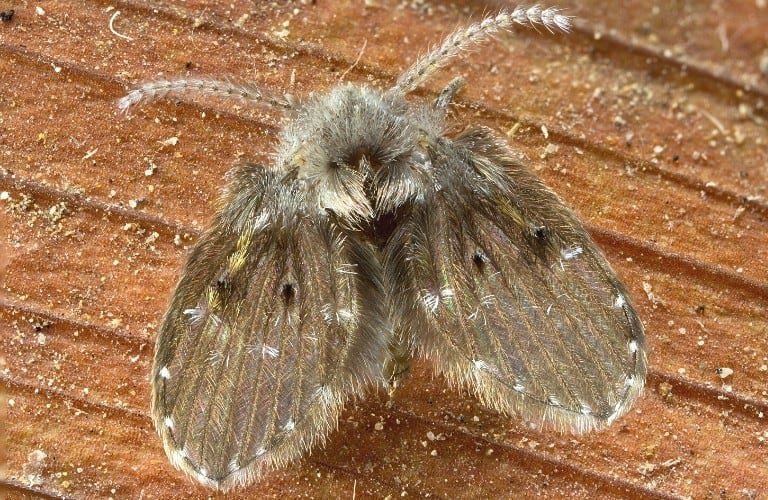Drain flies and fruit flies are common pests in the home that have many similarities.
However, there are key differences between the two that determine the best way to eliminate them.
What’s the difference between drain flies and fruit flies? Drain flies range from gray to black and have large oblong wings, long antennae, and hairy bodies. They eat decaying matter found in pipes. Fruit flies are dark yellow with stripes, long slender wings, short antennae, and less fuzzy bodies. They eat sugary foods.
Although both drain flies and fruit flies can be incredibly annoying, they are two separate insects.
In the following, you’ll see how they not only differ in appearance but also in diet, preferred environment, attractants, and behavior.
What Are Drain Flies?
Drain flies are small bugs that are also known as moth flies, sewer gnats, and sink flies.
They are most often found in the drains and pipe systems of bathroom or kitchen sinks, bathtubs, and showers.
Drain flies can even infest toilets and occasionally sump pumps as well.
Outdoors, they are often in areas with lots of standing water such as swamps, ponds, or pools.
They also swarm around human or animal feces.
Drain flies reproduce at a shockingly quick rate with females able to lay up to 300 eggs in 48 hours.
However, drain flies typically only live up to 24 days and are not very hardy.
Drain flies are not known to carry any diseases, and they do not bite or sting. However, they can be considered a nuisance.
Large amounts of dead drain flies can be an irritant to those with asthma.
Getting rid of drain flies for good isn’t too difficult if you are following the correct elimination steps and prevention guidelines. Check out all our drain fly articles to learn the proper procedures.
What Are Fruit Flies?
Fruit flies are another form of gnats. They eat decaying fruit or produce, which often leads them into the kitchen.
(Learn how to banish gnats from your home and plants here.)
In the kitchen, these little bugs breed very quickly, laying their eggs inside of and on top of decaying fruit.
Females lay up to 500 eggs, which begin hatching in as little as 24 hours.
Similarly to drain flies, fruit flies make their home and sometimes breed inside of drains or plumbing systems.
However, fruit flies are much more likely to live and breed out in the open.
Differences in Appearance
Drain Flies
Drain flies range in color from light gray or brown to black. Their long, scaly wings look similar to a moth’s wings.
However, these bugs do not fly long distances, preferring to jump or hop short distances and fly erratically in a jerky pattern for short periods .
Drain flies grow to 1 to 5 millimeters in length and have long antennae. They appear to be covered in fur similar to a caterpillar.
Fruit Flies
Fruit flies are usually light brown to yellow in color and have a striped body. They have either bright red eyes or black eyes, depending upon the species.
They are about the same size as drain flies, but their wings are not as widely set or scaly.
In fact, fruit flies look very similar to the common house fly, except much smaller.
Fruit flies are also less fuzzy than drain flies, making them appear slimmer.
Differences in Diet
Because these bugs are so small and move quickly, it is often difficult to determine one’s identity by its appearance.
Instead, look at the things they are eating.
Drain Flies
Drain flies feast on the decaying organic material found in sinks, bathtubs, and showers, as well as any other plumbing devices.
This material includes food, human skin cells, or feces. Because drain flies are so small, it does not take much food for a congregation to survive.
They particularly like stagnant water in drains and pipes which contains decaying organic matter.
When the water remains stagnant for long periods of time, a film develops. The film coats the inside of the pipes and the area just underneath the drain.
It is on the surface of this film that drain flies make their home and lay their eggs.
For a more in-depth look at what attracts drain flies, click here.
Fruit flies, on the other hand, do not require large amounts of water to survive. Instead, they get their moisture from their food.
Fruit Flies
Fruit flies eat anything that contains sugar. Often, this means exposed fruit and vegetables (fresh or rotting), juice, alcohol, or sweeteners.
Fruit flies are also known as vinegar flies, as they are also attracted to anything that is fermenting.
The natural sugars produced by fermenting food or drink is enough to feed a swarm of fruit flies.
The non-sugary, decaying organic matter that drain flies enjoy is not attractive to fruit flies.
On the other hand, drain flies will eat decaying fruit. They do not like to leave the safety and darkness of their natural habitats, however, so they are less visible than fruit flies.
How to Determine Which Is in Your Home
Location
Fruit flies typically congregate in the kitchen, unless there are other rooms in the home where there is food.
Drain flies are also attracted to the kitchen, especially the sink area. Additionally, the garbage disposal is a haven for these bugs that enjoy decaying food.
However, drain flies are also active in bathrooms, where they find their meals and moisture in sinks, toilets, and showers.
Thus, if you see these tiny bugs “hopping” through the air around your bathroom, they are probably drain flies.
Where Do They Land?
Drain flies are hesitant to come into the light unless disturbed. They prefer to stay in the drains and pipes of your home.
Thus, if a small bug lands on fruit or other exposed food or drinks and remains there, it is likely a fruit fly.
Fruit flies will often go into drains to eat rotting fruit or produce that has gone down but are less likely to lay eggs inside of a drain or pipe.
If a gnat heads toward the kitchen sink and stays there, it is most likely a drain fly.
Remove Fruit and Exposed Food
Make sure all the food in your kitchen is wrapped tightly or stored in airtight containers (these are perfect for dry goods).
Put anything perishable in the refrigerator.
Take out the garbage, as this is another area in which fruit flies congregate. Look carefully for rotting fruit or food in the trash can.
Often, fruit flies are the first ones to find rotting fruit or food, even before humans. Their hypersensitive smell receptors are able to sniff out food quickly.
If, after these things have been removed for several days, there are still tiny bugs flying around, then they are probably drain flies.
Put Tape Over Drains
A simple way to determine whether or not you have drain flies is to place a piece of tape, preferably duct, painter’s, or masking, over the top of the drain.
Leave it overnight. When you peel the tape away in the morning, you will be able to see whether or not any drain flies tried to escape.
Eliminating Drain and Fruit Flies
Even though these bugs have some differences, getting rid of them involves basically the same process.
The idea is to get rid of their food sources as completely as possible and kill the larvae.
Be sure to check with our article “How To Get Rid of Drain Flies” for a complete guide to prevention and effective elimination techniques.
Remove Food Sources
Removing the food sources of a fruit fly is simple: throw away any rotting fruit or vegetable as soon as it is no longer edible for humans.
- Store food and drinks, especially those that are fermented or contain sugar, in airtight containers.
- Keep the kitchen counters and sink clean, taking care to clean up all food remnants quickly.
- Frequently disinfect the kitchen and bathrooms.
- Always run the garbage disposal immediately after the food goes into it.
Kill the Larvae
Because fruit flies prefer to lay their eggs in and around rotting produce, throwing these things out will naturally eliminate the larvae.
Be sure to dispose of it in airtight, sealed bags so that the young fruit flies cannot escape once they hatch.
Consider purchasing a drain pesticide to ensure that you kill all the drain fly larvae.
Look for a product such as InVade Bio Drain Gel that has enzymes that eliminate any organic material in your pipes.
Killing the larvae will indeed lead to lower population of pests, but adults should be dealt with as well.
For fruit flies, a simple lure trap will draw adults in. They’ll be unable to escape and will quickly die.
You can see which traps we most recommend for drain flies in our article “Best Trap for Drain Flies,” but for now, here’s a quick peek at our top choice:
The greatest thing about this trap is that it is effective for both fruit flies and drain flies as well as mosquitoes, gnats, and other small, flying bugs.
Conclusion
If you notice tiny bugs flying around your home, pay careful attention to what they look like, where they live, and what attracts them.
Remove any food that is rotting or that is out in the open, as these things attract fruit flies and provide food for drain flies.
When trying to eliminate them, utilize a drain pesticide in addition to removing food sources.
Take these steps to eradicate bugs from your home for good!

